
In early 2001, with the introduction of its XC166 family of products, Infineon took the proven 16-bit architecture a stage further, achieving greater integration and higher performance. Now, the company has marked another important advance with its new XE166 microcontrollers, which again deliver a significant performance gain. This most recent generation of 16-bit controllers based on the C166 core also packs in substantially more Flash memory, plus a richer peripheral set.
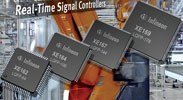
From the very beginning, the C166 architecture was designed for high realtime performance, with fast execution of instructions, rapid response times, and intelligent peripheral functionality. It proved to be an unprecedented success, with more than 500 million microcontrollers shipped to date. Compared to C164, C161 and C167 components, the XC166 family, clocked at 40 MHz, introduced a major performance boost and offered embedded Flash memory, single-cycle execution of instructions, and TwinCAN or on-chip debug system (OCDS) modules.
Compared to its XC166 predecessors, the XE166 family's new realtime signal controller (RTSC) delivers another substantial speed gain, said to be comparable to the performance level of 32-bit devices. The realtime performance is due to fast interrupt response times, rapid context switching, and the addition of two more local register banks.
All the XE166 family is based on the C166S V2 core. These high-performance RTSC products incorporate an MCU that unites the strengths of a 16-bit C166 core for peripheral control with the high computing power of a digital signal processor (DSP).
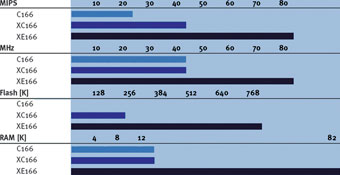
Clocked at 80 MHz and capable of executing instructions in a single clock cycle, XE166 chips deliver 80 MIPS - twice the performance of their predecessors, the XC166 family. Also, the XE166 family has three times the memory capacity - up to 768 KB. Besides substantially expanding the Flash memory, Infineon has also added highly effective error correction (ECC), capable of correcting single-bit errors and detecting double-bit errors. The significantly enlarged RAM (up to 82 KB) consists of 2 KB of dual-port RAM, up to 16 KB of data SRAM, and as much as 64 KB of program and data SRAM.
Architectural features
The recently launched XE167 and XE164 series, built around an expanded C166S V2 core with a five-stage pipeline, offer excellent performance for 16-bit solutions. Most instructions execute in a single cycle, with an execution time of 12,5 ns. The high DSP performance is capable of supporting even the most demanding realtime applications. For example, 16 x 16 MAC operations can be completed in just a single clock cycle, and 32 x 32 multiplications in just 15 cycles.
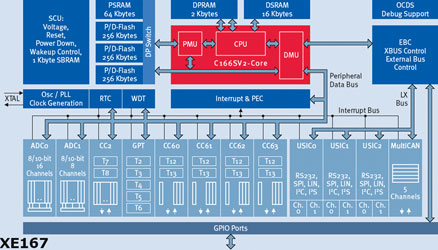
Integrated features, including a voltage controller, EEPROM emulation with additional Flash modules, an oscillator, a watchdog and brown-out detection, reduce the need for external components and, thus, the BOM system costs. Designers of embedded systems also benefit from the two separate voltage domains (3,0 V and 5,5 V) because the trend with digital functions (external memory, for instance) is toward lower voltages, whereas some analog functions like sensors offer a higher resolution at higher voltages.
Powerful peripherals
The high-performance peripheral functions include up to four capture/compare units (CCU6E) with a maximum of eight timers for controlling electric motors using sine algorithms and field oriented control schemes using space vector modulation. Each CCU6E consists of a T12 timer block with three capture/compare channels and a T13 timer block with a single capture/compare channel. The T12 channels can generate up to six PWM signals and accept six triggers. This allows the control of up to three power half-bridges with automatic dead time generation. Besides generating the signal patterns needed to drive AC motors or inverters, the RTSC provides special operating modes for controlling brushless DC motors.
The XE166 products have two synchronised AD converters with up to 24 channels, 10-bit resolution, and a conversion time of less than 1,2 μs. Tightly coupled with the PWM units (CCU6E), these high-precision AD converters can be used to control up to four motors.
The XE166 family also offers a wide variety of interface options. A MultiCAN interface, for example, supports up to five independent CAN nodes and a maximum of 128 message objects. This enables, say, a FIFO or a CAN gateway to be implemented, and is a valuable capability, given that complex applications often need intelligent network communication.
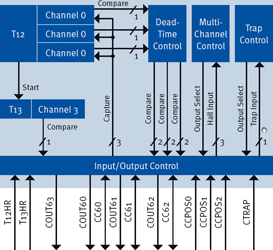
The XE166 can incorporate up to three universal serial interface channel (USIC) modules, each of which is a cluster of two identical USIC channels, providing six USIC channels in total. The channels are flexible and can be used to connect external peripherals over universal asynchronous receiver transmit (UART) and local interconnect network (LIN) interfaces, Serial peripheral interfaces (SPI), inter-IC (IIC) bus, and inter-IC Sound (IIS) interfaces. Every channel (and the baud rate generation) can be configured independently.
The XE164 is available in a 100-pin, lead-free LQFP (75 I/O pins) and the XE167 in a 144-pin LQFP (118 I/O pins), each with a 0,5 mm pitch. Both components operate with a 3,3 to 5 V power supply and in a temperature range from -40 to +85°C. The new controllers are backed by an extensive range of development tools and support on-chip debugging over a JTAG interface.
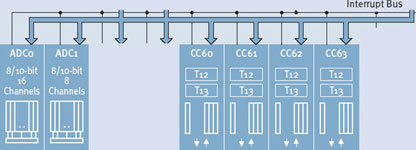
Realtime performance
Many applications that control electric motors need to be able to process a large number of external signals at high speed. The XE166 family, with its low interrupt response latency and fast context switching, is optimised for this kind of application. The CPU core, peripheral event controller (PEC), and peripheral functions are specially designed to enable efficient interrupt handling. The XE166 architecture also includes special mechanisms to enable rapid responses to internal and external service requests sent to the microcontroller. These include:
* A DMA transfer issued by the PEC.
* An interrupt system with up to 87 sources and selectable external inputs for interrupt generation.
* 16 interrupt priority levels, each with eight prioritisation groups.
* Extremely short interrupt response times.
The PEC allows data to be transferred between the memory and peripherals in just a single clock cycle, without requiring the intervention of an interrupt service routine. It does this by providing eight service channels over which a single byte or word can be transferred, plus the option of being able to update source and target pointers automatically. A PEC transfer can be triggered by an internal interrupt service request and offers the fastest possible interrupt response time.
Applications
The powerful CPU with 80 MIPS, the rich I/O functionality, flexible power management, and comprehensive peripherals all make the XE167 and XE164 ideal for use in a wide range of industrial systems. The microcontrollers are capable of handling anything from relatively simple control operations in pumps, fans, compressors and HVAC systems to considerably more complex tasks in servo drives, CNC machines, process control systems, robotics systems, power supplies and inverters.
Their advantages in terms of speed and simplicity of implementation and energy efficiency really show in applications involving multiple motors. The powerful CCU6E unit, with two timers for signal generation, enables engineers to create highly efficient designs, regardless of the type of motor to be controlled or the control algorithm.
Another field of application for the XE166 family is in high-efficiency control systems for inverters and voltage converters. They enable highly energy-efficient solutions in the transportation sector - in locomotives, streetcars, buses and agricultural machinery, for example - as well as in the renewable energy sector (in solar, fuel cell and wind power generating systems). With their fast interrupt timing and flexible PWM generation, they can be used to control anything from small machines to the high-voltage motors capable of replacing conventional hydraulic systems.
Comprehensive design support
Infineon offers a comprehensive set of developer tools for the XE166 family, including evaluation boards, debuggers, compilers and documentation, as well as DAvE (Digital Application Virtual Engineer), a tool for initialisation, configuration and code generation. All compilers for the XE166 family include an OCDS debugger, and some additionally offer a realtime kernel and simulator.
In addition, Altium, in association with Infineon, offers a free XE166 Tasking C compiler with a one-year licence. The Altium Tasking C166 Compiler Toolset developed specifically for the XE166 has powerful features. The integrated development environment eases access to the CrossView Pro source-level debugger, which simplifies connecting to any XE166 EasyKit evaluation board. Preinstalled, working design examples, step-by-step instructions and additional, advanced tools, including automatically generated start-up code, help developers embarking on the design process get up to speed quickly.

© Technews Publishing (Pty) Ltd | All Rights Reserved